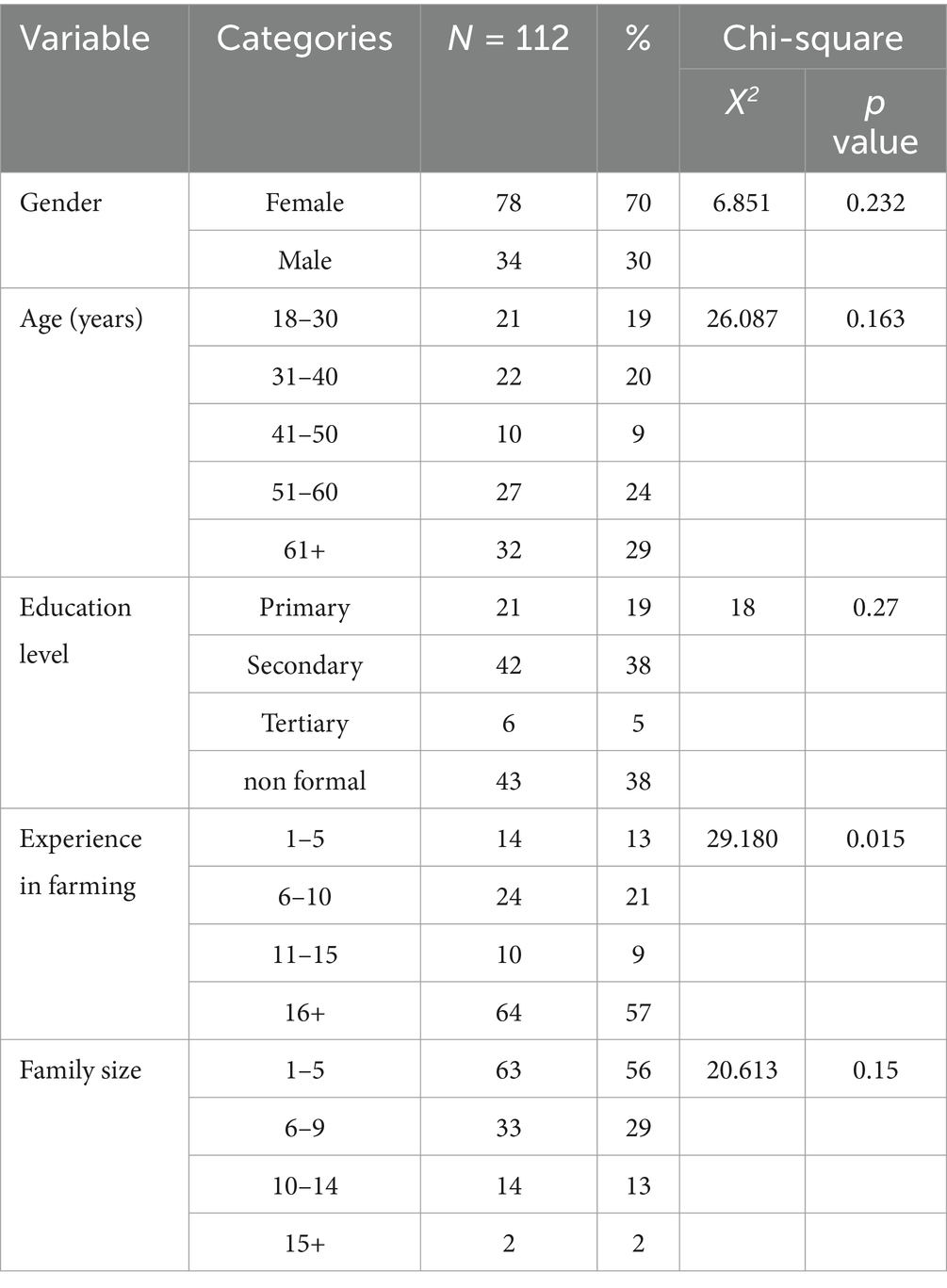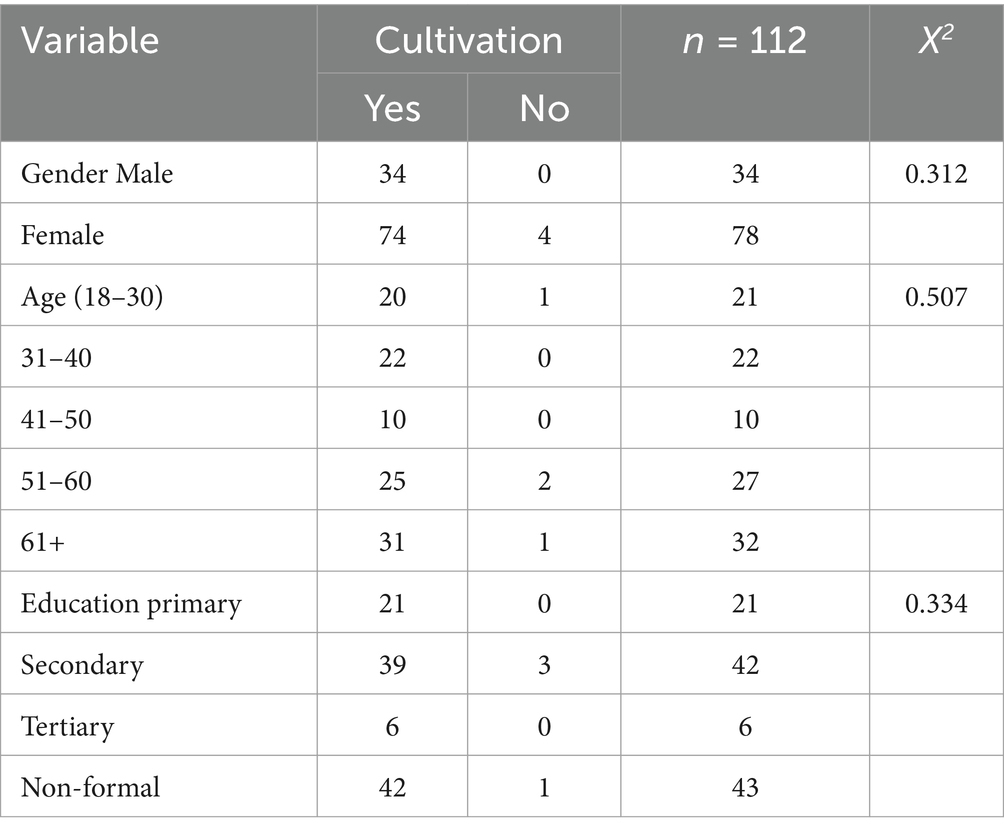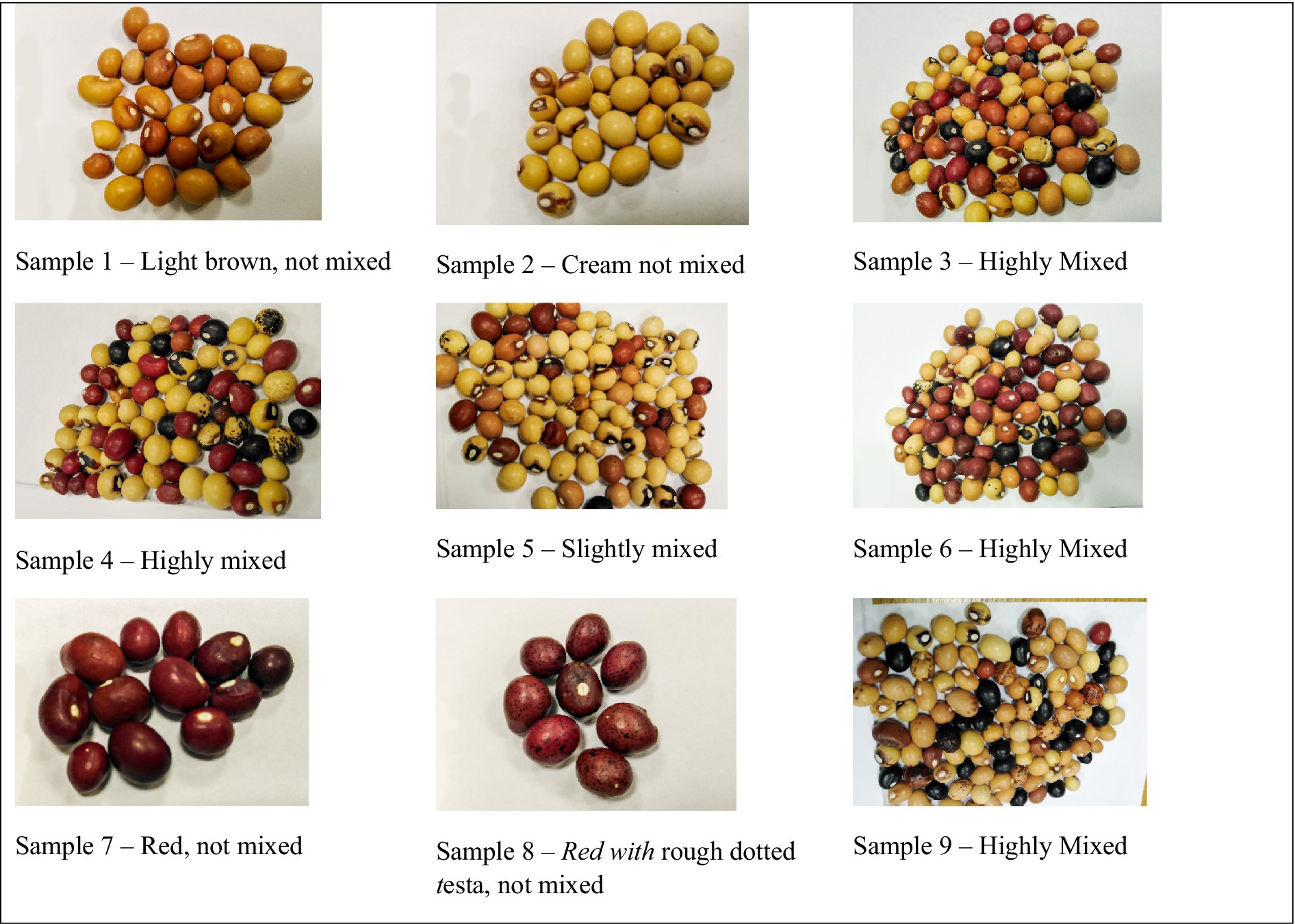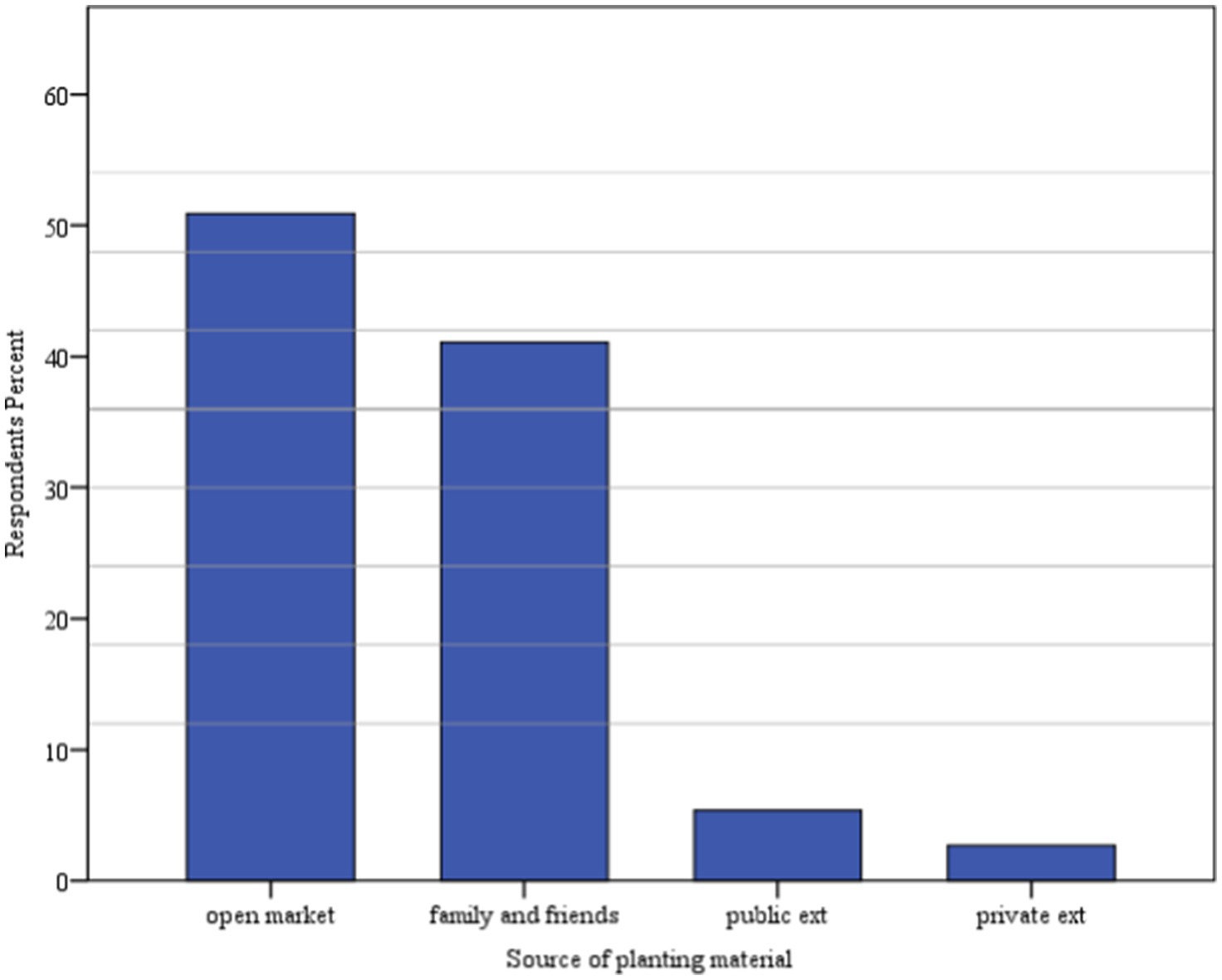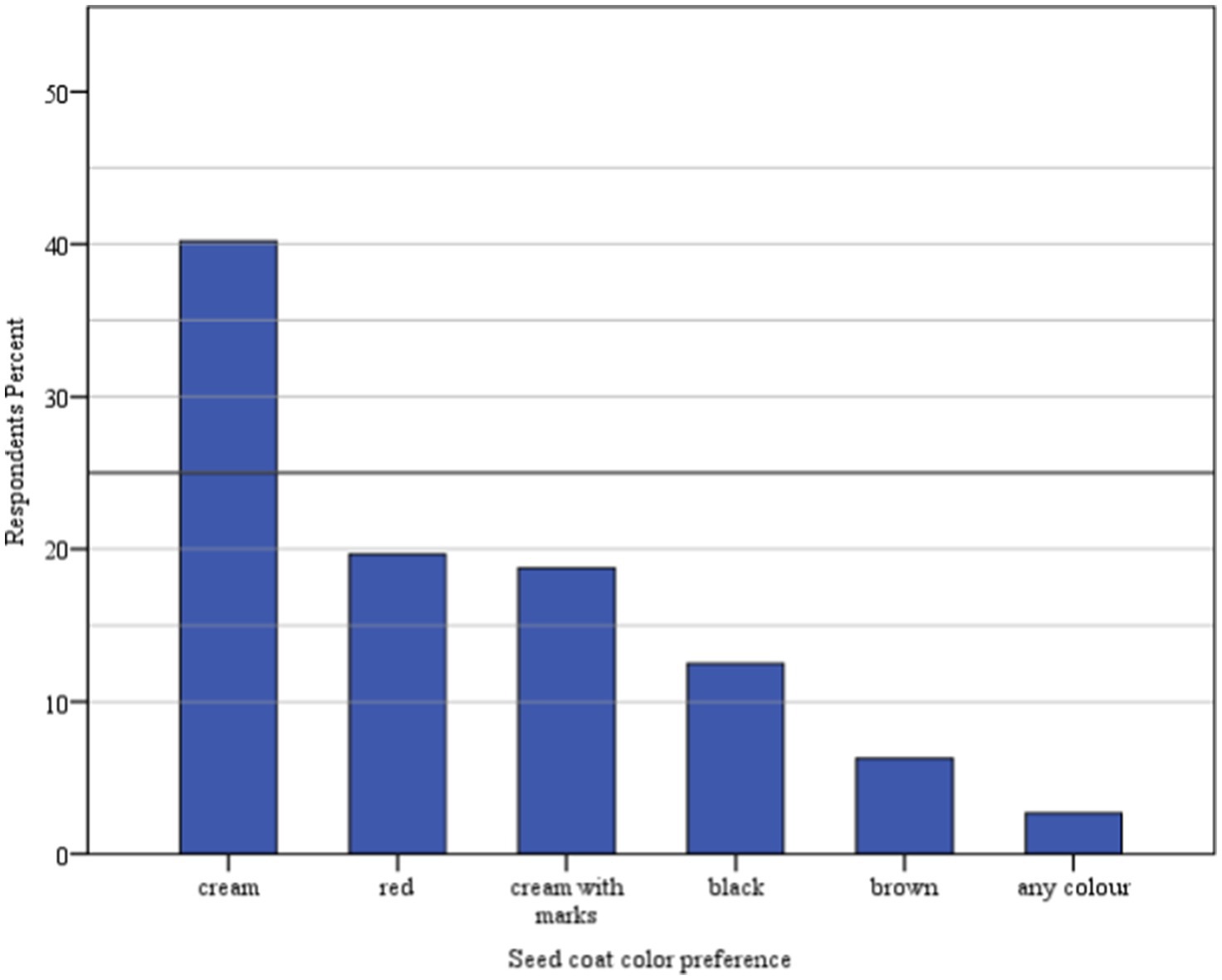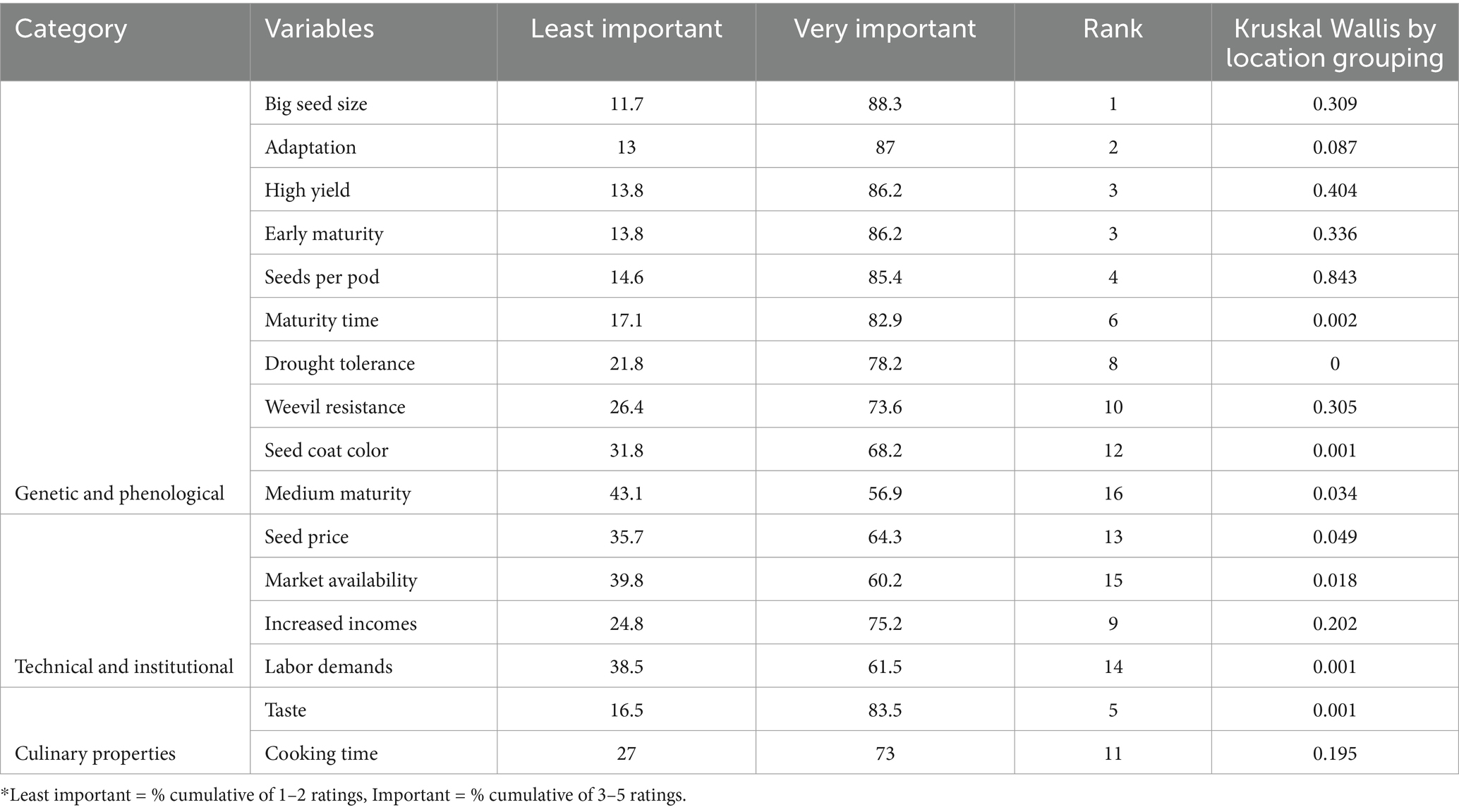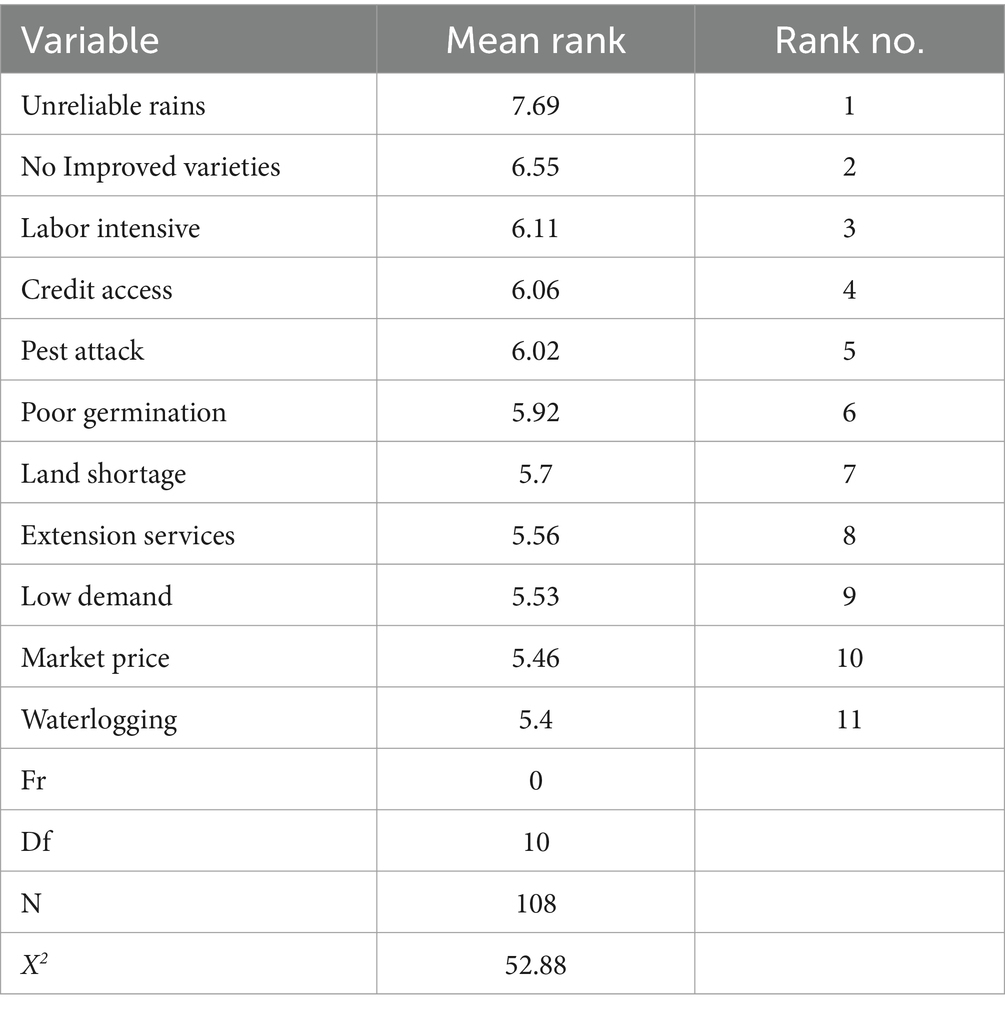- 1Department of Crop Production and Technologies, Faculty of Agriculture and Natural Resources, University of Namibia, Oshakati, Namibia
- 2Multidisciplinary Research, University of Namibia, Windhoek, Namibia
- 3Department of Animal Production, Agribusiness and Economics, Faculty of Agriculture and Natural Resources, University of Namibia, Oshakati, Namibia
- 4School of Agricultural, Earth and Environmental Sciences, University of KwaZulu-Natal, Pietermaritzburg, South Africa
- 5Center for Climate Smart Agriculture and Biodiversity Conservation, Hamaraya University, Diredawa, Ethiopia
- 6Laboratory of Genetics, Horticulture and Seed Science, Faculty of Agronomic Sciences, University of Abomey-Calavi, Cotonou, Benin
In Namibia, Bambara groundnut is one of the few legume crops grown for human consumption and adapted to the local growing drier conditions. However, the crop is produced at a subsistence level and sold as a boiled snack from the unshelled fresh pods. Its yield levels are low, and a dedicated crop improvement program is lacking. This study was carried out to determine the status of Bambara groundnut production and its constraints in Namibia. In addition, what are the farmer’s preferred varietal characteristics, choice of ideotypes, and motivators that can lead to more production of the crop. Data was collected through participatory approaches in four of the Bambara groundnut producing regions of Namibia, in the northern part of the country. The study involved 112 semi-structured interviews, 74 focus group respondents, and transect walks. Based on frequency tabulations, land preparation depended on tillage implements (43% of tractors and animal-drawn power each, and 11% hand hoes). The ridge and furrow was the widely adopted planting method (72%) and served as a coping mechanism to limited water resources. Farmers utilized indigenous knowledge on crop management and seed preservation. Most farmers (71%) grow mixed seeds, whilst 29% grow a pure stand. Varietal preferences were highly diverse on seed color (cream 40%, red 20%, cream mottled 19%, black 13%, other colors 3%). Informal channels dominated the seed distribution (51% open market, 41% as exchanges, 8% public-private). The chi-square test was used to examine relationships between categorical variables and test whether the variables were independent or associated. Findings revealed that it was a gender-neutral crop in production, although there were role-specificities for men and women. To compare motivators to increase Bambara groundnut production across the agroecologies, a Kruskal-Wallis test was conducted. The Friedman analysis of variance was computed to test for differences in production constraints, and the Wilcoxon Post hoc test was used for pairwise comparison of the constraints variables across the surveyed regions. Production constraints were many, however, unreliable rainfall and the absence of improved varieties were the most prevalent. The choice of ideotype that farmers preferred were early maturity, drought tolerance, high yield, prolificacy, and a bunched type. This study recommends breeding for higher yield, drought resistant and early maturing varieties in combination with the other preferred traits. In essence, pre-breeding strategies should incorporate earliness to maturity as a drought escape mechanism for the normal to below rainfall regions.
1 Introduction
Agriculture is the backbone of most African countries, however, most countries grapple poverty and undernourishment owing to the untapped agriculture potential (Mukasa et al., 2017) Globally, addressing food insecurity through crop improvement has largely focused on developing improved varieties of major food crops (maize, wheat, oil pulses, etc.), whilst African indigenous crops have been neglected and underutilized (Akinola et al., 2020). Among these crops are various roots and tubers, vegetables, trees and shrubs, and pulses with high nutritional levels, pharmaceutical properties, with good adaptation to harsh environmental conditions which can strengthen the water-food-nutrition nexus to achieve food and nutritional security (Mabhaudhi et al., 2019). Bambara groundnut [Vigna subterranea (L.) Verdc] is among the under-utilized and neglected legume crops with the capacity to improve soil fertility through nitrogen fixation and an important source of essential nutrients (Mubaiwa, 2018a). Bambara groundnut is produced for its edible seed which possesses high starch content (53%), of 15.7–35.3% amylose, 10.3% fibre content, and protein levels of 20–40%, nutrients levels deemed sufficient to be considered for the management of diabetics and cholesterol and protein malnutrition. This makes Bambara groundnut to become an important source of inexpensive protein that can provide a dietary complement to the largely cereal-based diets of Africa.
Bambara groundnut is native to Africa, and currently is produced in various tropical and subtropical regions of Africa, Asia and Australia. It is suitable for dry regions, thrives in warm climates, and is particularly well-suited to areas with limited rainfall (Majola et al., 2021). The crop prefers sandy or loamy soils, and is drought tolerant, thereby adapting well to arid conditions (Soumare et al., 2022). Namibia (22.9576° S, 18.4904° E) is the driest country south of the Sahara, of which 92 % is categorized as hyper-arid, arid, or semi-arid (Mendelsohn, 2002). Hot and dry conditions and low-uneven rainfall patterns often characterize the high variability of its climate. The climate and the soil conditions greatly impact the potential of most crops’ agricultural productivity (Mupambwa et al., 2019). Furthermore, climate change projections indicate a likelihood for pronounced changes in the country’s weather patterns which is likely to cause increased incidences of crop failures. It is predicted that for Namibia, rainfall might decrease and air temperature rise by 1.2°C in the southwest and 2.8°C in the northeast between 2036 and 2065 (Spear et al., 2018). Since Bambara groundnut possesses an intrinsic ability to withstand moisture stress this attribute favorably places it as a crop of agronomic importance in water-limited conditions.
In production systems, this crop is predominantly produced by subsistence farmers under rain-fed agriculture with minimal inputs. Consequently, its production and productivity remains low at about 195,151 tons that are cultivated on about 253,973 ha with an average yield of 0.85 t/ha (Mayes et al., 2019). A myriad of production constraints including the absence of improved varieties, markets, and credit accessibility and climate variability have been identified to hinder Bambara production (Ibrahim et al., 2018; Mukakalisa, 2010). Bambara groundnut is also produced in Namibia although detailed information of the production metrics is scanty. Meanwhile, it is the second most important traditionally grown legume of importance after cowpea where it is produced as a secondary crop (Fleißner, 2006), possibly due to these legume’s adaption to drier conditions. Popular knowledge suggests that local subsistence farmers are aware and have adopted this crop for nutritional and cultural values, but on small portions of land (<1 ha), often sandy and infertile soils known as “omahenge” (Fleißner, 2006). Unlike the staple crops (Pennisetum glaucum and Zea mays) and cowpea (Vigna unguiculata) cultivated locally, improved seeds of Bambara groundnut are not available for the farmers hence farmers rely on selections from landraces as planting material.
Genetic improvement of Bambara groundnut is of paramount importance to achieve high yield and attain the desired agronomic attributes and enhance its productivity and production. For targeted breeding programs, the strategic and technical partners in Bambara groundnut have identified several traits of importance, These traits include drought tolerance, seed size, and color, earliness of maturity, nutritional value, water use efficiency, pest and disease resistance, photoperiod sensitivity (Mayes et al., 2019). However, the absence of crucial phenotypic information is a challenge that affect the establishment of orphan crop improvement programs (Tan et al., 2020). According to Massawe et al. (2005) farmers’ traits of preference may represent additional traits of importance in crop improvement programs which often suit their unique agro-ecologies and socio-cultural considerations. Therefore, participatory plant breeding and soliciting indigenous knowledge becomes relevant in guiding pre-breeding efforts. Incorporating farmers as significant stakeholders can assist with key information of the crop’s most important traits and its unique adaptive features. This is deemed so since farmers have successfully preserved its landraces and cultivated it through indigenous knowledge over generations (Mayes et al., 2019). Deploying such an approach can help to develop varieties that have both the breeder’s strategic and farmer’s preferred traits.
Participatory plant breeding (PPB) refers to a collaborative approach in varietal development which is shared among the plant breeders and the intended beneficiaries of the plant breeding products (Bhargava et al., 2019). In practice, among other factors, PPB seeks to systematically connect the breeding process with the ground reality of the production environment, to harness farmers’ and consumer’s preferred traits, and at the same time addressing the major production constraints. PPB has been shown to be an opportunity to increase variety adoption rates in farming systems. Towards the genetic improvement of Bambara groundnut in Namibia, national Bambara groundnut improvement program was established in 1995. In addition, a collaborative project BAMFOOD the (ICA4-CT-2000-30002) between 2000 and 2003 with the national program was established to determine the Bambara groundnut ideotypes and consumer preferences from Omusati region in north-central Namibia. The project led to an assembly of purelines which were isolated from seed mixtures of landraces based mainly on seed characteristics (Fleißner, 2006; Mukakalisa, 2010). However, a lack of continuity on the breeding programs disrupted the progress towards varietal development. As a result, to date there are no improved varieties of Bambara groundnut available in the market. As enshrined in the policy documents, there are renewed efforts to revive the Bambara groundnut breeding crop as part of the country’s strategic crop to enhance climate change resilience and food security.
In this study, we sought to understand the present socio-economic conditions of Bambara groundnut producers, their needs, perceptions, production constraints, and varietal preferences. This information is vital to guide in the establishment of possible improvement strategies that are based on farmers’ priorities across diverse production environments. The following research questions were addressed (1) What are the implications of indigenous knowledge in production, conservation, and crop production, (2) the factors that farmers perceive can contribute to increased uptake of Bambara groundnut in their farming systems, and (3) What are the preferred characteristics of Bambara groundnut and the farmers’ choice of ideotypes that should help in developing breeding objectives when re-establishing a national breeding program?
2 Description of study sites
The study was carried out in four regions in the north-central and north-east of Namibia where Bambara groundnut is mostly produced (Figure 1) between October 2018 and June 2019. Omusati and Ohangwena are regions in north-central of Namibia, and the local groups in the study were the “Aawambo.” In northeast Namibia respondents were drawn from Kavango East and Kavango West regions, and the ethnic groups were the “gciricu” and “vakwangali” respectively. The study areas according to the Köppen climate classification are categorized as the BSh, which corresponds to the hot semi-arid, although the annual average rainfall, temperature, and biome vary (Table 1). The rainfall of northern Namibia is characterized by a unimodal distribution from October to April, with north-east (Kavango regions) receiving high and consistent rainfall as compared to Omusati and Ohangwena regions in north-central Namibia (Awala et al., 2019). Although the soils of the study areas were mostly sandy, specifically the Kalahari sands, spatial variation exists mostly notable in Kavango regions. The soils are usually aeronosols, which are a product of wind depositions, or fluvisols, which are formed due to deposition of soil on the floodplain, and anthrosols, which are a mixture of the aforementioned. On the other hand, soils in the north-central are sandy, and thereby inherently low in nutrients together with a poor water holding capacity. Thus in Kavango regions, agricultural productivity is deemed to be higher due to high rainfall and soil types which tend to offer conducive conditions for diverse crops than in north-central Namibia.
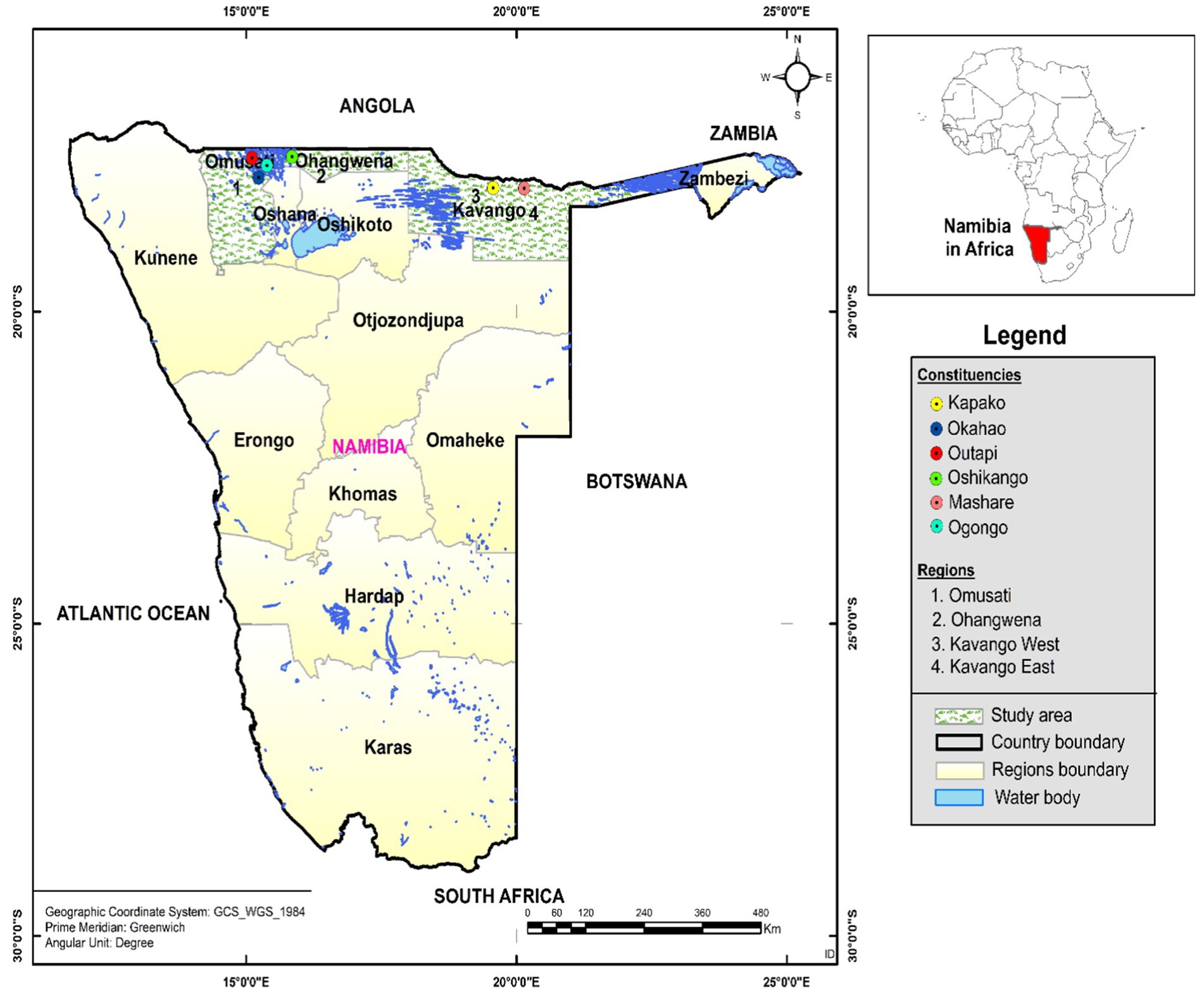
Figure 1. Map of the surveyed regions and constituencies towards a client-oriented varietal development.

Table 1. Location, average temperature, rainfall, and biome of study areas in northeast and central Namibia.
2.1 Sampling procedures
A multistage sampling approach was adopted in this study. A purposive sampling approach was employed to select the four selected regions and constituencies in which participatory rural appraisal activities were done in north-central and east Namibia since these regions are among the areas where Bambara groundnut is produced in the country. The regions where respondents were drawn from were Omusati, Ohangwena, Kavango East, and Kavango West regions. In Kavango West respondents were drawn from Kapako, in Kavango East was Mashare, in Omusati were from Ogongo, Okahao, and Outapi, whilst in Ohangwena participants were from Oshikango constituency. A proportionate sampling technique was deployed to determine the number of respondents per constituency of the region. Thus respondents from Ohangwena were (40%), Omusati (42%), Kavango East (14%) and Kavango west (16%) of the survey sample size. At least 5–8 villages were selected with the help of extension service agents in the region depending on the importance given to the Bambara groundnut. In the study areas, about 98% of the households produce Bambara groundnut thus a simple random sampling was followed to interview individuals from households on the criteria of the first adult (18 and above years), to be identified at a household. The sample size was determined through the coefficient of variation (CV) method proposed by Nassiuma (2000), as a prerequisite, a CV of less than 30% is recommended (Okuthe et al., 2013). The CV method is given as
Where n = sample size, N = target population (N = 633,442), cv. = co-efficient of variation which was taken as 0.21, e = 0.02 or at 98% confidence level. In this study, the total rural population was derived from https://namibia.opendataforafrica.org/gallery/census-data of Omusati, Ohangwena, Kavango east and west regions. As a result, the number of households interviewed were 112.
2.2 Data collection
Data was collected using 112 semi-structured questionnaires, seven mixed-gender focus group discussions of 7–12 participants from the 74 respondents, transect walks and 2 key informant interviews from the Ministry of Agriculture, Water, and Forestry scientific officers were interviewed as subject matter experts to validate the findings. The district extension officers facilitated the focus group discussions, while the village herdsmen facilitated the household questionnaire data collection.
The questionnaire which was created in English was translated for the local languages (Oshiwambo and Rukwangali) and enumerators who were bi-lingual (English and the local language) interviewed farmers from the study areas. Data were collected on demographic information, social norms, Bambara groundnut farming systems (farm size, land allocated to Bambara groundnut and other main crops, and varieties cultivated), farmers’ trait preferences of Bambara groundnut varieties. Besides, the varieties cultivated, the criteria of their preference, supply of the seeds, motivators towards increased production of the crop, constraints related to production, and postharvest management, especially seed storage were collected.
To characterize respondents’ age, groups were categorized into 18–30, 31–40, 41–50, 51–60, and 61+ years. Gender was classified as female or male. Education levels were classified under primary, secondary, tertiary, and non-formal categories. To determine how much each respondent has been involved in Bambara groundnut production, the farming experience was grouped into 1–5, 6–10, 11–15, and 16+ years. Family size was used to determine labor available to produce the crop in the household. It referred to the number of individuals who belonged to a household during the cropping season and was characterized numerically as 1–5, 6–9, 10–14, and 15+ adult persons.
The questionnaire was divided into several parts. The first section asked questions in relation agro diversity to determine which crops were grown in the surveyed areas. The respondents were asked to list these in order of importance and specify whether the crops were grown mainly for household food, income generation, or both. The second section investigated on Bambara groundnut’s diversity, on-farm conservation, and utilization. The questions checked whether the respondents grew Bambara groundnut in their household and if it was produced individually or by a group of farmers or farmer groups. Farmers responded as Yes or No. For the planting material, farmers responded on the source of seeds they planted, and responses included whether they acquired from outside countries. What were the farmers’ preferred seeds concerning seed characteristics and agronomic attributes? How much seed do the farmers save from the previous harvests to use for planting in the next season? For own production, did the farmer prefer to plant mixed seed grains or sole color seeds? The third section asked questions about how Bambara groundnut was produced. The questions included does the farmer own or rent land, farm type, it being communal, commercial, or peri-urban, ploughing method deployed to include mechanical, manual or animal draft power. The planting methods were ridge, farrow, flat, broadcast or heap. Farmers were to state whether they produced the crop as a monocrop or intercrop with other crops. For socio-cultural and economic attributes farmers were asked about their perceptions on whether yes or no Bambara groundnut improved incomes, nutrition, and soil fertility. The fourth section asked about constraints to Bambara groundnut production. Farmers responded on a Likert scale 1 = not important, 2 = fairly important, 3 = important, 4 = very important, 5 = most important. The study listed eleven variables that had been published in previous works by (Fleißner, 2006) as constraints to Bambara groundnut in one of Namibia’s crop-growing regions of Omusati. The variables spanned across the whole value chain from production, market access, demand and consumption, and weather-related institutional factors such as extension services and credit access. The fifth section considered the aspects of varietal preferences in terms of grain size, number of seeds, maturity, color, and taste. Lastly, to determine what motivates farmers to increase Bambara groundnut production, farmers ranked the following attributes maturity, income, yield, drought tolerance, taste, adaptation, cooking time, seed size, pest resistance, and market availability.
2.3 Data analysis
Qualitative and quantitative data was coded and analyzed using the Statistical Package for Social Sciences (SPSS) version 20 (IBM Corp, 2011). Data for production constraints and motivators for increased production was coded on a Likert scale, where 1 = not important, and 5 = very important. Data on farming cultivation and perceptions were coded as Yes and No bivariate responses. Data were subjected to analysis using the chi-square cross-tabulation and descriptive statistics such as frequencies and percentages were determined. The chi-square test was used to examine relationships between categorical variables and test whether the variables were independent or associated. To compare motivators to increase Bambara groundnut production across the agro ecologies, a non-parametric analysis of variance of the Kruskal Wallis test was conducted. The Friedman analysis of variance was computed to test for differences of production constraints and the Wilcoxon Post hoc test was used for pairwise comparison of the constraints variables across the surveyed regions.
3 Results
3.1 Socio-economic descriptions of respondents
There was a higher proportion of females in both the questionnaire survey (70% females and 30% males) and focus group (60% females and 40% males) interviews, respectively (Table 2). The age group category of 61+ had the greatest number of respondents (29%), whilst the 41–50 had the least (9%) participants. Less than 5% had a tertiary qualification, whilst 38% had either a secondary or non-formal education. The nuclear family size of less than 5 had the largest frequency of 56%. There were no significant differences on gender, age, education level and family size, however the farming experience varied (15, N = 112) =29.80, p = 0.015, of which 13, 21 and 9% of participants possessed 1–5, 6–10 and 11–15 years respectively, whilst 57% had more than 16 years. Responses from focus group discussions revealed the gender roles underlying Bambara groundnut production. Land preparation was done by men, sowing by women and children, weeding and earthing by both women and men, harvesting by women and children, and selling by women.
3.1.1 Cultural practices and gender roles in Bambara production
There was no association between gender, age, and educational level with cultivation, implying that Bambara was a gender-neutral crop in Namibia, with men and women performing different roles in production and selling (Table 3).
3.2 Tillage and cropping system
The most employed tillage methods were the ridge and furrow (72%), flat (15%), broadcast (7%), and heaping (6%). The planting method was influenced by the ploughing method (12, N = 112) =30.69, p = 0.002, 43% used tractors, 43% animal draft power, while 11% used the manual hand hoeing technique and 3% ploughed any method. Across the surveyed regions, the cropping systems varied (10, N = 112) =46.34, p = 0.000, whereby 75% of farmers practiced mono-cropping, whilst 25% of farmers intercropped Bambara with companion crops such as maize and pearl millet. About 61% perceived crop rotations with Bambara enhanced soil fertility, whilst 39% deemed otherwise.
3.3 Local names of Bambara groundnut
In Kavango West, farmers referred Bambara to as “Nongomene” among the Gciricu ethnic group, with specific varietal names such as “Malukusu,” “oshiwambo,” and “singolosi.” In Kavango East, Bambara was referred to as “nyimu” amongst the “Rukwangali” ethnic group, whilst there were no specific varietal names. Similarly, in Omusati region, there were no specific varietal names of Bambara groundnut in Okahao, Outapi and Ogongo constituencies/districts, but it was locally referred to as “eefukwa.” Seed coat color was the descriptor used in identifying and naming varieties and farmers indicated the names of the varieties as “Egogani” – cream with a black eye, “Ondudhe” – black, “Oheva” – brown, and “Okatotombe.”
3.4 Bambara groundnut planting material, sources of seeds, varietal preferences
About 98% of the farmers grew Bambara groundnut and 71% grew mixed seeds (sample 3, 4, 5, 6 & 9), whilst 29% grow a pure stand (sample 1, 2, 7 & 8 in Figure 2). The samples of Bambara groundnut presented below were used during the study as a reference to various seed morphotypes that are grown and consumed in northern Namibia. The main seed source was mainly open markets (51%) and exchanges with family and friends (41%) (Figure 3). About 3% of the farmers had acquired seed from Non-Governmental Organizations and private seed houses. Another 5% had previously received seeds from the Government Directorate of Agricultural Production, Engineering and Extension Services (DAPEES).
3.4.1 Preference of seed coat color in Bambara groundnut production and consumption
A higher proportion of farmers preferred cream and cream with marks/mottled cream (40%), followed by red (22%), cream mottled (21%), black (14%), and any seed coat color (3%) (Figure 4). In production, the red seed types belonged to the long maturing group, and often produced larger sized grains than the cream types. Most farmers in Omusati and Ohangwena regions do not cultivate the non-mixed red seeded types, as most farmers were not familiar with that seed class. About 52% preferred to consume it when it was being harvested as fresh pods and boiled as a snack, whilst 45% preferred either boiled dry grain or fresh pods, and 3% the dried only (Figure 5). Farmers used seed coat color to distinguish on taste. Lighter colored coat (cream, light brown) was considered less bitter, whereas the darker colors (red, dark brown, black) were considered very bitter. About 55% of respondents preferred less bitter, whilst 5% bitter taste, and the remaining 44% non-bitter (sweet) Bambara groundnut of large grain or pod sizes.
About 93% perceived Bambara groundnut to provide nutritional benefits, whilst 7% deemed otherwise. Consumption patterns highlighted that ‘once in a week consumption’ was the most frequent, followed by ‘once in a fortnight’, and 20% ‘once-daily’ (Table 4). Regions with the crop’s production were associated with higher consumption frequency. Cooking time was one of the challenges contributing to a reduction in the frequency of consumption of Bambara due to the hard seed coat.
3.4.2 Uses, social norms, and seed preservation of Bambara groundnut
Bambara groundnut was grown for home consumption, whilst in Kavango West, it could be produced for selling to generate income. About 75% acknowledged that Bambara groundnut could generate income for the household, whilst 25% differed. Its seed are the part used for human consumption and the plant material that remains after harvesting can be fed to animals such as goats. 70% indicated that social influences do not contribute to the production of Bambara groundnut, whilst 30% considered otherwise. As part of the tradition, the grain could be given as a gift in Kavango West, particularly to newly married women as they start their new homes or when a family is relocating to a new homestead. The farmers used indigenous knowledge for seed preservation against insects and loss of viability. The widely used practices involved threshing dried pods and storing the seeds in bottles with ash, under cool dry conditions. Alternatively, the farmers do not thresh it until the next planting season for better protection from weevil infestation.
3.5 Factors considered in improving production levels by the farmers
Bambara groundnut was produced on areas ranging from 1/3 ha to 2.5 ha. The preferred characteristics and factors that could lead to increased cropping area were big seed size, adaptation, high yield, early maturity, and higher number of seeds per pod [2–3 (Table 5)]. Market availability, labor, and seed price were ranked the least by the farmers. The Kruskal Wallis test (Table 5) across the surveyed constituencies indicated that participants’ responses on increased incomes from selling Bambara groundnut, high yield, early maturity, the adaptation to local growing conditions, prolificacy, seeds per pod (2–3 seeds), big seed size, cooking time, and weevil resistance were in agreement. On the other hand, across the locations, participants’ responses varied on maturity time, seed coat color, drought tolerance, taste, labor demands, market availability, and seed price.
3.6 Production constraints of Bambara groundnut in northern Namibia
The Friedman ANOVA results (Table 6) respondents’ ranking of production challenges was significantly different X2 (10, N = 108) =52.88, p = 0.000. The highest mean ranked challenge was unreliable rainfall, then lack of improved varieties and labor-intensive demand of the crop (Table 6). The problematic insects and pests were ants, pod borers, rodents, and weevils. The least limiting factors were waterlogging, grain market price, low demand, absence of extension services, and land shortage, respectively. Across the surveyed regions, waterlogging constraint was reported only in the Omusati region due to the presence of a Cuvelai basin locally referred to as “Oshanas” which hold water during the rainy season for extended periods especially after heavy rainfall or in seasons of normal to above normal rainfall.
In this study, the Bambara groundnut production constraints were manifold. Since the Friedman ANOVA results were significantly different we conducted pairwise comparison of the constraints by performing the Wilcoxon Post hoc test. Unreliable rains were the most important limiting factor and were highly significant with all the variables (Table 7). The absence of improved varieties was the second-ranked production constraint (Table 7) and was significant with financing, the market price fetched by the grain in the market, poor germination, low demand, land shortage, and waterlogging (Table 7). The lack of extension services variable was only significant with the unavailability of improved varieties and unreliable rains. Pest attacks was significant with unreliable rains, land shortage, and waterlogging. Labor-intensive demand for the crop was significant with waterlogging, market price, low demand, and land shortage. Land shortage and waterlogging which were noted as the least limiting factors to Bambara production were significant with unreliable rains, no improved varieties, labor intensive, and pest attacks.
4 Discussion
Bambara groundnut is an important leguminous crop in Namibia. The results showed that the production of Bambara groundnut had no significant association with education and age. However, literature posits that the level of education influences the ease by which training programmes on various farming aspects can be set up in the communities, thus influencing the adoption of new technologies (Sibiya et al., 2013). This could suggest that the Bambara groundnut is grown by almost all farmers with access to the seed across all education levels and age groups. Age structure composition and the amount of farming experience affect agricultural productivity and output (Guo et al., 2015). The 61+ age category possessed more years of farming experience, of which the experience diminished with the decreasing age of respondents. Consequently, this has a bearing on the crop’s long-term cultivation. Given that it is an orphan crop, incentives to attract its adoption by the younger generation through mechanization, end-use product, and source of income should be enhanced.
Bambara groundnut was considered a secondary crop in northern Namibia, thus priority in land allocation was given to staple crops such as pearl millet in Omusati and Ohangwena regions, and maize crop in some parts of Kavango region. The main crops grown in order of importance in north-central Namibia (Omusati and Ohangwena) were pearl millet, cowpea, sorghum, Bambara groundnut, and cucurbits, whilst in northeast Namibia were pearl millet, maize, Bambara groundnut, cowpea, sorghum, and hibiscus vegetable. It had been established that the food diversification index for the rural population was low in Namibia, with a score of 2.5 out of 10, with a predominance of cereal, roots, and tubers consumption (Heim, 2021). However, the survey revealed that farmers’ perception of Bambara groundnut has improved substantially notably in Kavango west region. In this area, Bambara groundnut has been ranked third and first in crops and legume of importance respectively, as compared to the 90’s when it was ranked 6th (Fleißner, 2006). Bambara groundnut can be grown as a sole crop or intercrop (El Bilali et al., 2024). Most farmers produced Bambara groundnut as a sole crop, rather than an intercrop. Intercropping involves growing different crops on the same piece of land. Specifically, the farmers grow the crop for diversification as it was considered handy during the dry months as a food and nutrition source. There still exist considerable knowledge gaps regarding the potential benefits of the crop on agro ecology and nutrition. This warrants the need to increase efforts to disseminate information about the contribution of the crop to sustainable agri-food systems.
Intermittent dry spells or flooding conditions are common during Namibia’s seasonal rainfall. The ridge and furrow technique can serve to conserve water in-situ in the furrows or facilitating an aerated rooting zone of the plants during waterlogging conditions (Ghosh et al., 2014). The farmers mostly adopted the ridge and furrow planting as an adaptive mechanism that helped to utilize limited water resources. The ridge and furrow method was facilitated by mechanical and animal draft power, whilst farmers who use hand hoeing emphasized that they could produce on a relatively small area. Therefore, optimization of farm power in the form of draught, mechanical, and manual is of paramount importance in increasing agricultural production and reducing discomfort associated with agricultural operations. To optimize crop performance and obtain higher yields, it is of paramount importance to enhance good agronomic practices to complement good genetic attributes. These can include incorporating other techniques such as planting stations and mulching to further enhance soil moisture retention, especially in the sandy soils that are prevalent in most parts of northern Namibia.
The development of varieties of Bambara groundnut by conventional and modern genetic tools is in its infancy, as such no improved varieties exist for farmers (Mabhaudhi et al., 2019; Olanrewaju et al., 2022). Farmers grow landraces obtained from a series of selective breeding efforts, often without hybridization to attain the desired combination of traits. In this study, farmers specified the limited genetic diversity present in their locally available Bambara groundnut landraces. It was established that the contribution of the formal seed distribution system was little. Informal seed supply and seed exchanges have played a crucial role in the cultivation of Bambara over generations. To widen their variability in their cultivation material, farmers not only sourced in open markets in proximity to their localities, but from inter-regional open markets as well, and exchanged seed with families and friends. According to the open market traders, some grain they sold was acquired from traders from neighboring countries of Zambia and Angola. As noted in other countries recycling of on-farm seeds can be beneficial towards conservation efforts of the landraces (Mubaiwa et al., 2018b). In addition, indigenous knowledge particularly of vernacular names and characteristics in the various production has played a pivotal role in the conservation, management, and utilization of genetic resources. For example, farmers associated the cream color with early maturity of about 3 months, and the red color with relatively longer maturity of four to 5 months to harvest of mature fresh pods for cooking. This information was vital when the farmers sourced seeds for planting. Nonetheless, there is need to strengthen the seed supply system, assembly germplasm and establish community gene banks to ensure farmers have access to quality, diverse and well-adapted seeds.
Bambara groundnut has good nutritional and agro ecological qualities, but its ability to contribute significantly to the global food system is limited by various challenges. According to Tan et al. (2020), constraints of Bambara groundnut include limited knowledge in improved seed system, agronomic practices, processing, and utilization. In Namibia, unreliable rainfall and lack of improved varieties were the most prevalent challenges in Bambara groundnut production. Bambara groundnut research has been known to be underfunded globally (Soumare et al., 2022). This has resulted in limited capabilities to address its production constraints. Our survey results indicated that some of the challenges currently being faced by the farmers in Namibia have been longstanding. Previous studies had reported about the challenges of seed quality, unstable yields, low uniformity, lack of a seed system, postharvest insect pest damages, land shortages, and climate variability particularly recurrent drought and floods (Fleißner, 2006; Mukakalisa, 2010). To date some of these challenges persist. It is of paramount importance that a dedicated national program and solutions be devised to adequately these limitations.
Nevertheless, the absence of formal markets, extension services, and land shortages were perceived as less important constraints. In the same manner, market availability, labor, and seed price were ranked the least by the farmers on the motivators to increase the crops production. This highlights that farmers do not perceive Bambara groundnut as a cash crop, despite its potential in nutrition, agro ecology and ingredient in making flour. Similar findings were reported on the perceptions of the adoption of Bambara groundnut in Kenya (Wasula et al., 2014). Unlike in other production regions of Africa where it is sold locally and or can be exported (Mubaiwa, 2018a), farmers in Namibia highlighted that they produce mainly for home consumption. Few sell their produce to local markets in neighboring towns and open markets, and prices often do not vary between seasons. In Namibia, Bambara groundnut is widely consumed as a boiled snack, a factor which limits options in utilizing the grain in dishes. These utilization and marketing patterns have been reported in South Africa (Department of Agriculture, Forestry and Fisheries, 2016). Various processing techniques to reduce cooking time, combined with options of preparing such as roasting, and end products derived such as flour, milk etc. have been reported elsewhere (Mayes et al., 2019; Mubaiwa et al., 2018b). El Bilali et al. (2024) proposed the need to develop the entire value chain from production to processing, consumption and marketing to unlock the crop’s benefits. Simultaneously, such efforts can in turn drive the crop’s demand and spur its production and breeding programs.
Seed coat color is an important descriptor in Bambara and is often associated with taste, size, and maturity characteristics (Department of Agriculture, Forestry and Fisheries, 2016). In Namibia, farmers preferred different seed coat colors, but mostly light colored implying that serving the local markets would require a portfolio of grain skin color and its combinations. Larger grain size was almost universally preferred as consumers considered big pods and big seeds. In South Africa, similar findings have been reported (Department of Agriculture, Forestry and Fisheries, 2016). Earliness to maturity was another consideration by the producers given the short and low annual precipitation associated with the Namibian local climate. The preferred characteristics and factors that could lead to increased cropping area were big seed size, adaptation, high yield, early maturity, and higher number of seeds per pod (2–3). Breeding crops for drought-affected environments and improved climate resilience present an opportunity to mitigate climate change effects (Cooper and Messina, 2023). For self-pollinated crops like Bambara groundnut, researchers can leverage on traditional and marker-assisted breeding plus high throughput phenotyping to develop improved varieties of Bambara groundnut. By integrating modern technologies with indigenous knowledge, Bambara groundnut breeding can contribute to sustainable agriculture, particularly in marginal environments. To enhance the breeding process, a participatory varietal selection framework needs to be implemented to involve stakeholders until the final product of the breeding program is released. Therefore, the ideal Bambara groundnut that is most preferred should be light-colored, large grain size and early maturing and drought resistant including less bitterness.
5 Conclusion and recommendations
Farmers grew landraces obtained from a series of selective breeding efforts without hybridization to attain the desired combination of traits. Formal breeding activities are indispensable to develop new varieties, however, they may not always meet the unique needs of local farmers. This points out the need to expedite pre-breeding efforts to improve the productivity of Bambara groundnut, and at the same time improve crucial traits combinations. We recommend that a national Bambara groundnut that follows a participatory and demand-driven breeding approach be established in the country. A targeted breeding program is vital to develop improved varieties that have good traits. Based on the survey outcomes, the choice of ideotype of a Bambara groundnut crop should possess early maturity, drought tolerance, high yield, and prolificacy (2–3 seeds per pod) with large-sized seeds, light-colored, and a bunched type. To enhance production of Bambara groundnut there is need for (1) development of formal seed systems and community and national gene banks to strengthen capacity to assemble neglected and underutilized species, (2) mechanization for ridge and furrow and lessening the labor-intense requirements of the crop need to be considered to increase land under Bambara groundnut production, and (3) farmers preferred different seed coat colors, thus serving the local markets would require a portfolio of grain skin color and its combinations. The study recommends that the Namibia Agricultural Mechanization and Seed Improvement Project (NAMSIP) should be leveraged on to include crops such as Bambara groundnut to develop its formal seed systems. In addition, researchers can leverage on global collaborations and networks working to strengthen Bambara groundnut genetic diversity and genomic resources to enhance institutional and technical capabilities. These include the International Institute of Tropical Agriculture (IITA), African Orphan Crops Consortium (AOCC), Vision for Adapted Crops (VACS), and Crops for the Future (CFF) among others. Factors that hinder Bambara groundnut production were many. Therefore, it was prudent to identify the most limiting factors that could be addressed concurrently. In this study in Namibia, unreliable rainfall and lack of improved varieties were the prevalent challenges in Bambara groundnut production. As part of the study strength’s, our study involved questionnaires, focus group discussions, and key informant interviews, which allowed for cross-validation and were crucial for improving the reliability and robustness of the findings. Quantitative and qualitative data enabled the researchers to gauge opinions and helped to answer why some respondents’ perceptions were so. As part of the limitations, on the individual variables the respondents expressed their opinions, and as such must be treated.
Data availability statement
The raw data supporting the conclusions of this article will be made available by the authors, without undue reservation.
Ethics statement
The studies involving humans were approved by University Research Ethics Committee Decentralised Ethics Committee. The studies were conducted in accordance with the local legislation and institutional requirements. The participants provided their written informed consent to participate in this study.
Author contributions
JP: Conceptualization, Formal analysis, Investigation, Methodology, Software, Visualization, Writing – original draft. LH: Project administration, Supervision, Writing – review & editing. CT: Formal analysis, Methodology, Software, Validation, Writing – review & editing. JS: Conceptualization, Funding acquisition, Methodology, Project administration, Supervision, Validation, Writing – review & editing. RM: Formal analysis, Methodology, Software, Writing – review & editing. EA-D: Conceptualization, Funding acquisition, Project administration, Resources, Supervision, Visualization, Writing – review & editing.
Funding
The author(s) declare that financial support was received for the research and/or publication of this article. This work was supported by the “Intra-Africa Academic Mobility Scheme” under the project Grant number 2016-2988.
Conflict of interest
The authors declare that the research was conducted in the absence of any commercial or financial relationships that could be construed as a potential conflict of interest.
Generative AI statement
The authors declare that no Gen AI was used in the creation of this manuscript.
Publisher’s note
All claims expressed in this article are solely those of the authors and do not necessarily represent those of their affiliated organizations, or those of the publisher, the editors and the reviewers. Any product that may be evaluated in this article, or claim that may be made by its manufacturer, is not guaranteed or endorsed by the publisher.
References
Akinola, R., Pereira, L. M., Mabhaudhi, T., De Bruin, F.-M., and Rusch, L. (2020). A review of indigenous food crops in Africa and the implications for more sustainable and healthy food systems. Sustain. For. 12:3493. doi: 10.3390/su12083493
Awala, S., Hove, K., Wanga, M., Valombola, J., and Mwandemele, O. (2019). Rainfall trend and variability in semi-arid northern Namibia: implications for smallholder agricultural production. Welwitschia Int. J. Agric. Sci. 1, 1–25. doi: 10.32642/wijas.v1i0.1364
Bhargava, A., Srivastava, S., Bhargava, A., and Srivastava, S. (2019). “Toward participatory plant breeding” in Participatory plant breeding: Concept and applications (Singapore: Springer), 69–86.
Cooper, M., and Messina, C. D. (2023). Breeding crops for drought-affected environments and improved climate resilience. Plant Cell 35, 162–186. doi: 10.1093/plcell/koac321
Department of Agriculture, Forestry and Fisheries. (2016). Bambara Groundnuts (Vigna subterranea). Available online at: https://www.dalrrd.gov.za/phocadownloadpap/Brochures_and_Production_Guidelines/Bambara.pdf (Accessed March 20, 2024).
El Bilali, H., Kiebre, Z., Nanema, R. K., Dan Guimbo, I., Rokka, V.-M., Gonnella, M., et al. (2024). Mapping research on Bambara groundnut (Vigna subterranea (L.) Verdc.) in Africa: bibliometric, geographical, and topical perspectives. Agriculture 14:1541. doi: 10.3390/agriculture14091541
Fleißner, K. W. E. (2006). The improvement of Bambara groundnut production in northern Namibia by means of breeding strategies and agronomic investigations. [Dissertation/Doctoral Thesis]. Namibia: University of Namibia.
Ghosh, P., Kumar, N., Venkatesh, M., Hazra, K., and Nadarajan, N. (2014). Resource conservation technology in pulses. India: Scientific Publishers.
Guo, G., Wen, Q., and Zhu, J. (2015). The impact of aging agricultural labor population on farmland output: from the perspective of farmer preferences. Math. Probl. Eng. 2015, 1–7. doi: 10.1155/2015/730618
Heim, A. (2021). Food environment research among an indigenous community in Namibia–a new approach to explore food security of rural people in developing countries. J. Hunger Environ. Nutr. 16, 809–828. doi: 10.1080/19320248.2019.1649780
Ibrahim, A. R., Dansi, A., Salifou, M., Ousmane, A., Alzouma, A., and Alou, W. (2018). Farmers’ practices, utilization, conservation and marketing of Bambara groundnut (Vigna subterranea (L.) Verdc.) in Dosso region, Western Niger. Genet. Resour. Crop Evol. 65, 1907–1914.
Mabhaudhi, T., Chimonyo, V. G. P., Hlahla, S., Massawe, F., Mayes, S., Nhamo, L., et al. (2019). Prospects of orphan crops in climate change. Planta 250, 695–708. doi: 10.1007/s00425-019-03129-y
Majola, N., Gerrano, A., and Shimelis, H. (2021). Bambara groundnut (Vigna subterranea [L.] Verdc.) production, utilisation and genetic improvement in sub-Saharan Africa. Agronomy 11:1345. doi: 10.3390/agronomy11071345
Massawe, F., Mwale, S., Azam-Ali, S., and Roberts, J. (2005). Breeding in bambara groundnut (Vigna subterranea (L.) Verdc.): strategic considerations. Afr. J. Biotechnol. 4, 463–471.
Mayes, S., Ho, W. K., Chai, H. H., Gao, X., Kundy, A. C., Mateva, K. I., et al. (2019). Bambara groundnut: an exemplar underutilised legume for resilience under climate change. Planta 250, 803–820. doi: 10.1007/s00425-019-03191-6
Mendelsohn, J. (2002). Atlas of Namibia: A portrait of the land and its people. Cape Town: New Africa Books (Pty) Ltd.
Mubaiwa, J. (2018a). Managing the hard-to-cook (HTC) phenomenon in Bambara groundnut (Vigna subterranea (L.) Verdc.) processing for resource limited communities in Zimbabwe.
Mubaiwa, J., Fogliano, V., Chidewe, C., Bakker, E. J., and Linnemann, A. R. (2018b). Utilization of bambara groundnut (Vigna subterranea (L.) Verdc.) for sustainable food and nutrition security in semi-arid regions of Zimbabwe. PLoS One 13:e0204817. doi: 10.1371/journal.pone.0204817
Mukakalisa, C. (2010). Molecular, environmental and nutritional evaluation of Bambara groundnut (Vigna subterranea (L.) Verdc.) for food production in Namibia. [Dissertation/Masters Thesis]. Namibia: University of Namibia.
Mukasa, A. N., Woldemichael, A. D., Salami, A. O., and Simpasa, A. M. (2017). Africa’s agricultural transformation: identifying priority areas and overcoming challenges. Afr. Econ. Brief 8, 1–16.
Mupambwa, H. A., Hausiku, M. K., Nciizah, A. D., and Dube, E. (2019). The unique Namib desert-coastal region and its opportunities for climate smart agriculture: a review. Cogent Food Agric. 5:1645258. doi: 10.1080/23311932.2019.1645258
Okuthe, I. K., Kioli, F., and Abuom, P. (2013). Socio cultural determinants of the adoption of integrated natural resource management technologies by small scale farmers in Ndhiwa division, Kenya. Curr. Res. J. Soc. Sci. 5, 203–218. doi: 10.19026/crjss.5.5557
Olanrewaju, O. S., Oyatomi, O., Babalola, O. O., and Abberton, M. (2022). Breeding potentials of Bambara groundnut for food and nutrition security in the face of climate change. Front. Plant Sci. 12:798993. doi: 10.3389/fpls.2021.798993
Sibiya, J., Tongoona, P., Derera, J., and Makanda, I. (2013). Farmers’ desired traits and selection criteria for maize varieties and their implications for maize breeding: a case study from KwaZulu-Natal Province, South Africa. J. Agric. Rural Dev. Trop. Subtrop. 114, 39–49.
Soumare, A., Diedhiou, A. G., and Kane, A. (2022). Bambara groundnut: a neglected and underutilized climate-resilient crop with great potential to alleviate food insecurity in sub-Saharan Africa. J. Crop Improv. 36, 747–767. doi: 10.1080/15427528.2021.2000908
Spear, D., Zaroug, M., Daron, J., Ziervogel, G., Angula, M., Haimbili, E., et al. (2018). Vulnerability and responses to climate change in drylands: The case of Namibia. London, UK: International Development Research Centre and UK Aid.
Tan, X. L., Azam-Ali, S., Goh, E. V., Mustafa, M., Chai, H. H., Ho, W. K., et al. (2020). Bambara groundnut: an underutilized leguminous crop for global food security and nutrition. Front. Nutr. 7:601496. doi: 10.3389/fnut.2020.601496
Keywords: Bambara groundnut, landraces, dryland cropping, orphan crop, participatory led pre-breeding, climate change
Citation: Pasipanodya JT, Horn LN, Togarepi C, Sibiya J, Musango R and Achigan-Dako EG (2025) Exploring farmer perspectives on Bambara groundnut [Vigna subterranea (L.) Verdc]: production constraints, preferred varietal traits and implications for varietal development in northern Namibia. Front. Sustain. Food Syst. 9:1520677. doi: 10.3389/fsufs.2025.1520677
Edited by:
Prakash Kumar Jha, Mississippi State University, United StatesReviewed by:
Deepranjan Sarkar, Asian Institute of Technology, ThailandAbhishek Panchadi, Mississippi State University, United States
Suyog Chaudhari, Jacobs Engineering, United States
Copyright © 2025 Pasipanodya, Horn, Togarepi, Sibiya, Musango and Achigan-Dako. This is an open-access article distributed under the terms of the Creative Commons Attribution License (CC BY). The use, distribution or reproduction in other forums is permitted, provided the original author(s) and the copyright owner(s) are credited and that the original publication in this journal is cited, in accordance with accepted academic practice. No use, distribution or reproduction is permitted which does not comply with these terms.
*Correspondence: Josephine T. Pasipanodya, am9zeXBhc3lAZ21haWwuY29t
†Present address: Julia Sibiya, Vision for Adapted Crops and Soils (VACS) Capacity Sustainable Agrifood Systems Program (SAS), International Maize and Wheat Improvement Center (CIMMYT) World Agroforestry Centre (ICRAF) Campus, United Nations Avenue, Gigiri, Nairobi, Kenya
 Josephine T. Pasipanodya
Josephine T. Pasipanodya Lydia N. Horn
Lydia N. Horn Cecil Togarepi
Cecil Togarepi Julia Sibiya
Julia Sibiya Rudo Musango
Rudo Musango Enoch G. Achigan-Dako
Enoch G. Achigan-Dako